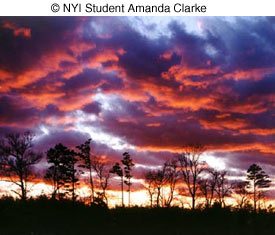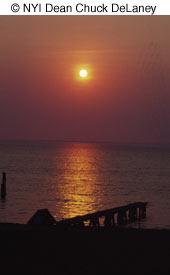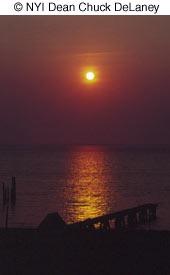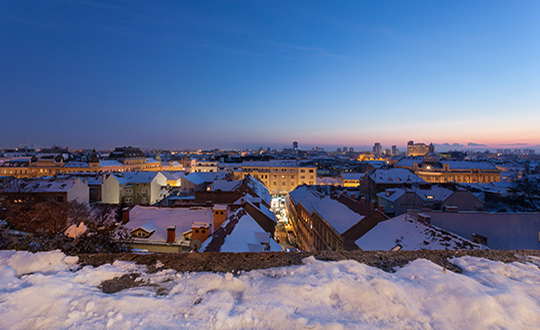"Ah, Krakatoa, now those were sunsets! If only we had color film back then!" -Quote from the old, old, old photographer.
With Iceland's Eyjafjallajokull volcano filling the skies of Northern Europe and Britan with ash from multiple eruptions, photographers in the areas where the ash is drifting may be in for some great sunsets for quite some time. This article will help you take great sunset photos whether they are caused by volcanic eruptions or not.
We know a photographer who visited Hawaii exactly once, and then only for two hours while changing airplanes for a flight to Japan. He had time to take a few pictures right around the airport, including a photograph of that evening's dramatic sunset with a palm tree in the foreground. He sold that image over and over again through his stock photo agency and made a total of $17,000.
Not bad for a two-hour layover in Hawaii. Sunsets sell!
We get a lot of questions at the Institute about how to take great photographs of sunsets. The truth is, it's easy. The hard part is finding a great sunset and being ready at the right time. We promise that if you follow the tips in this article, you'll be ready when you find the perfect sunset.
The sun sets every day, but to get a perfect sunset picture you need the right conditions of dust and clouds.

The dusky-red of the setting sun is the result of dust in the air. Where does it come from? Wind blows lots of dust from the ground up into the air. And smoke and industrial pollution provide dust too (it's one of the few benefits of air pollution). So do forest fires. Perhaps the biggest contributor of all is volcanic eruptions. There's nothing like a volcano to launch a huge payload of dust and smoke into the upper atmosphere from which it circles the globe.
When the old, old, old photographer stopped by the office last month, he reminded us that the eruption of Mount Krakatoa in 1883 is said to have produced beautiful sunsets for over a year around the entire world! In recent years, beautiful sunsets have been credited to the eruption of Mount St.Helens in Washington, Mount Pinatubo in the Philippines, and most recently, Mt. Etna in Italy. Now it's Mt. Redoubt's turn.
Clouds help too. Whether it is thick clouds that obscure portions of the sky or wispy clouds that take on colors of their own, the most dramatic sunset pictures almost always include clouds.
We usually think of sunsets in conjunction with beaches and islands. Why? Does humidity and water have something to do with sunsets? The answer is yes...and no. Large masses of water and a hot sun do combine to produce dramatic clouds.

But that's not the main reason we usually see the most dramatic sunsets from a beach. The reason is more subtle.
The main reason we associate beaches with sunsets is that they give us an unobstructed view of the setting sun on the horizon. No mountains in the way. No buildings. No city lights. Just a flat horizon and the setting sun. Plus a smooth expanse of water to reflect the colors!
Plus, if you're hanging around on the beach, you're probably relaxed and in the mood to enjoy a great sunset. You have time to watch the sun go down and savor the changes that take place over time.
Before we turn to photography, one other question: Why are sunsets more often dramatic than sunrises? Assuming you're the type who gets up early enough to even see the sunrise, the polluting smokestacks usually aren't as active at night, and the cool air of nighttime is less likely to be as windy as the hot air of late afternoon. So, when it comes to exciting skies to photograph when the sun crosses the horizon, the sunset is king! Turn your camera to the west.

Now, what's the best way to photograph the sunset?
The questions we hear most often involve what exposure to use. The answer is that there are a range of correct exposures. If you use your camera's built-in meter, you will usually be way off because the sky is still relatively bright, and the meter will underexpose the image. If you have a separate light meter, your best approach is to try to meter the ambient level of light. To do this either take an incident-light reading, or take a gray-card reading. Either approach will usually give a proper exposure. However, to be on the safe side, we suggest you take a number of bracketed shots.
Bracketing is a technique used by professional photographers to get the best exposure, which sometimes isn't the exposure the meter claims is the right exposure. To bracket, if your meter tells you to expose the scene at 1/60 of a second at f/8, then make the photograph and then take another frame at 1/60th at f/5.6 (one stop more exposure)and another at 1/60th at f/11 (one stop less exposure). This way, you have taken frames with more and less exposure than that which the meter indicates. The photos below were taken with a one stop difference in exposure. You may find that a slightly lighter or darker version of the scene may give a more pleasing overall exposure.

What if you don't have a separate meter or a way to control your camera's aperture and shutter speed? As long as your camera has auto-exposure lock, you can still bracket...only you'll do so by "fooling" the camera. Here's how... First, point your camera at the sunset and take the indicated exposure. Second, point your camera at the ground where it's darker, lock the exposure, recompose on the sunset, and take another exposure. Third, point the camera at the sky, lock the exposure, recompose on the sunset, and take another photograph. You should now have three different exposure settings for the sunset!
There's another aspect of exposure for a sunset — timing. Sunsets aren't static. They happen over time. When you prepare to take those sunset pictures, plan to spend at least half an hour, so you can photograph the scene every five minutes or so. Clouds move, colors deepen and change, and the image you record a little later as the sunset unfolds may have more drama and richer colors than you saw fifteen minutes before. Take lots of pictures, and choose the best of them later when you see the results.
What about composition?
Even the most spectacular sunset will look like abstract wallpaper if you don't provide some context. Silhouetted trees or other objects in the foreground give a sense of scale and location to the scene. A great sunset will have a different feeling if it's taken at the beach with a few palm trees in the foreground. (Don't forget our friend who sold $17,000 of such an image!)
Of course, dramatic sunsets, despite what we've said about beaches and islands, can be seen in other places too. Wherever, see if you can place an interesting object in the foreground — for example, a Civil War monument in the foreground of a sunset at Gettysburg. What about mountains? They make wonderful images, but they often present a problem when it comes to sunsets. If the mountain is tall, the sun will set behind it while still glowing a bright yellow. The mountain may rise too far above the dust-laden horizon for you to see the deep red hue of the setting sun.
What focal length should you use for a great sunset? Figure it this way. The longer the lens, the larger the sun will appear in the picture. The surprising fact is that the sun in reality is only one-half a degree in diameter. What this means is that, if you shoot with a "normal" lens — say a 50mm — the sun will be less than 1/80th the width of the frame! You want the red globe of the sun to be a lot more significant than this. To achieve this, use a very long lens — 200mm is the minimum...400mm or longer is even better. One point, however: With such long lenses, be sure to support the camera on a tripod, monopod, or convenient flat surface since the exposure will be relatively long and you want to prevent camera shake.

WARNING: It is dangerous to your eyes to look directly at the shining yellow sun. Don't look directly at it until it is low enough in the sky to have turned red. If you're using a long lens, this is especially important. The lens is like a telescope. It magnifies the intensity of the sunlight. Don't look at the sun through the lens until the flaming yellow glow has turned a dark red.
If you use film, what should you use for sunset photos? Almost any film will do. Some pros want the "grainless" look of Kodachrome. Others will use their regular ISO 800 film, and see no difference. Our recommendation: ISO 200 or 400 will be fine. These ISO are good settings for use with a digital camera as well.
Here's a subject where slide film will record subtle differences in bracketed exposure better than color-negative film. Each slide provides you with an image that precisely reflects the exposure you gave the film. With color negative film, your efforts at giving more and less exposure through bracketing will often be minimized because the automatic printing machines will guess at the exposure you "meant" to give. If you have "custom" prints made by a lab, be sure to tell the technician you want to preserve the different exposures of your bracketing.
There are a few things that are different about shooting sunsets with a digital camera. Let's turn to them now.

Shooting Sunsets With a Digital Camera
Using a digital camera to photograph a sunset requires you to follow some common rules. Let's look at some of the similarities as well as the distinct differences too.
White Balance
White balance refers to the correctness of color in a photographic scene. The white balance feature in most digital cameras ensures that color appears correct regardless of the lighting conditions. Theoretically, if the white balance is correct, then all of the colors in the scene are correct too.
The first and perhaps easiest method is to shoot RAW files in the ìAutoî white balance mode. The camera will automatically select the white balance for you, and allow you to focus your efforts on composing a great image. However, you will most certainly need to correct the white balance later in the digital darkroom during the RAW conversion process. For sunsets, you will likely find that the ìcloudyî or ìshadyî presets will more closely resemble the actual look of the scene. While this is a useful method, we here at NYIP believe in getting it right in the camera the first time. Not only is this the mark of a true professional, but it will save you post-processing time later.
Rather than allowing the camera to think for you, try using ìCustomî white balance. When you get to your location, start by taking a full frame image of a neutral gray or white card. Next, select the custom white balance in the LCD menu screen. The camera will then ask you to choose an image to set the white balance with. Select the image you just took of the neutral card, and you now have a custom set up for the scene before you. Please note that different camera manufactures have various ways to set Custom WB, so check your manual for their specific procedure.

Highlights
Another major consideration for those shooting digitally is how to handle the highlights. Much like slide film, digital sensors are quite sensitive to light. Even if you are very careful, itís easy to overexpose the bright areas of a scene. Most camera manufactures have responded to this situation by including a user selectable ìhighlight priorityî feature. It works by allowing more detail to be preserved in the lightest areas of the image. This is not only useful for bright sunsets and clouds, but for white wedding dresses as well. Of course proper exposure is still necessary, but this just may give your image that extra bit of dynamic range to really make it stand out. Weíve seen some examples of this mode, and can tell you that it truly works well. Donít just take our word for it, try it yourself.
Sun Can Damage CCDs
It's never a good idea to point a digital camera directly at any intensely bright light-source. Direct exposure to the sun while it is high in the sky can damage the delicate image sensor found in most digital cameras, the CCD. Fortunately as the sun approaches the sunset its intensity will diminish greatly. That's primarily because the light rays become scattered as they pass through atmospheric haze and pollutants that surrounds the earth. The closer the sun gets to the horizon, the safer it will be to point a digital camera at it. Never stare at the sun. You will cause damage to your eyes.
Auto-Focus
Very bright objects in the center of the frame can confuse the Auto-Focus feature found on most digital cameras. You can avoid the problem altogether by switching to Landscape mode. Landscape mode sets the camera lens to Infinity ensuring sharply focused sunsets.

Turn around!
Many times we get so caught up in photographing the sunset itself that we forget about the beautiful light that is being produced by this modified light source. Turn around and take notice of the golden light a sunset provides.
Golden Light
Don't stop shooting after the sun has dropped below the horizon. The light levels may be low but the quality of the light is pure beauty. Try shooting a portrait in this light and you'll be amazed at the rich golden tones you'll get.
Why is the quality of light so special? With the sun below the horizon, the sky essentially becomes a huge soft box, spreading reflected light through the atmosphere without the harshness and shadows of a point source such as the direct light of the sun.
The bottom line is digital cameras will perform better under soft reflected light conditions. Take advantage of this golden light, it doesn't last long.

Use a Tripod
Because of low light levels, shooting sunsets may require long exposure times, so you'll need a tripod. Exposure times of one or two seconds are common when shooting sunsets. Many digital cameras have replaced the cable release with a remote control. If your camera has one, bring it. This will reduce the possibility of camera shake during exposure times.
Include Foreground elements
Consider including foreground elements such as an interesting a tree or house into your scene. Just because you are shooting a sunset doesn't mean you only have to include the sun. Because of the direction of the light, foreground elements will almost assuredly be reproduced as silhouette, which can help to build visual drama in a sunset image.
Conclusion
A sunset is one of those moments in life that is often overlooked. Despite their regularity, each and every sunset is unique and anything but common. Perhaps that is what spurs us to grab our cameras and start shooting like today's sunset is the first one we have ever seen. In a way, it is.
If you follow these simple procedures, you're sure to get great sunset pictures. As we said at the head of this article, the problem is to get to a place that has great sunsets. The rest is easy!






